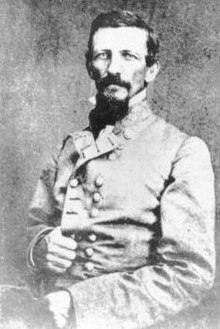 Alexander Peter Stewart (October 2, 1821 – August 30, 1908) was a career United States Army officer, college professor, and a general in the Confederate States Army during the American Civil War. He fought in many of the most significant battles in the Western Theater of the war, and briefly took command of the Army of Tennessee in 1865.
Alexander Peter Stewart (October 2, 1821 – August 30, 1908) was a career United States Army officer, college professor, and a general in the Confederate States Army during the American Civil War. He fought in many of the most significant battles in the Western Theater of the war, and briefly took command of the Army of Tennessee in 1865.
Civil War service
At the start of the American Civil War in 1861, although he was a strong anti-secessionist Whig politically, Stewart accepted a commission as major in the artillery of the Tennessee Militia on May 17. Shortly afterwards he entered the Confederate Army on August 15 as a major of artillery.[1]
Stewart was appointed a brigadier general on November 8 and assigned to command the 2nd Brigade, 2nd Division, Columbus District, of the Confederate Department No. Two (the precursor to the Department of Tennessee), under Leonidas Polk. Stewart held this position from November 16 until that December, when his brigade was transferred to the Department’s First Geographical Division, until February 1862. His brigade was returned to western Kentucky, briefly being added to John P. McCown’s division, leading the defenses of the town at the Battle of New Madrid before McCown ordered it evacuated and withdrew down the Mississippi River. On April 1, Stewart’s men joined Charles Clark’s division, in Leonidas Polk’s corps, of Albert Sidney Johnston’s Army of Mississippi, just in time for the Battle of Shiloh. There, Stewart led his brigade in first-day attacks on the “Hornet’s Nest” area in the center of the Union line.
Following Johnston’s death, command of the Army of Mississippi fell to P.G.T. Beauregard for the Siege of Corinth, where Stewart was present. President Davis soon replaced Beauregard in favor of Braxton Bragg, who transported the army to Chattanooga, Tennessee, in preparation for his invasion of Kentucky. In the Confederate Heartland Offensive, Stewart’s brigade fought at the Battle of Perryville in Benjamin Cheatham’s division of the army’s right wing, commanded by Polk. The Army of Mississippi became the Army of Tennessee near the end of 1862, and Stewart and his brigade served continued to serve in Cheatham’s Division in Polk’s First Corps at the Battle of Stones River. Stewart was promoted to divisional command and to major general on June 2, 1863,[1] assigned to William J. Hardee’s corps for the Tullahoma Campaign. His division unsuccessfully opposed General George Henry Thomas’s corps at the Battle of Hoover’s Gap before his division was assigned to Simon Bolivar Buckner’s corps and fought at the Battle of Chickamauga, Stewart being wounded in the fight on September 19.[1] Prior to the second day, Buckner’s corps was assigned to the army’s left wing to be commanded by the recently arriving James Longstreet. Following Chickamauga, Buckner was demoted by Bragg and left for Virginia on medical leave; Longstreet left soon after to besiege Union-controlled Knoxville. Stewart’s division remained at Chattanooga, and was assigned to John C. Breckinridge’s corps, for whom he and his men fought on the extreme left of the Confederate line at the Battle of Missionary Ridge in November 1863.
Stewart fought at the battles of Rocky Face Ridge, Resaca, and New Hope Church, commanding a division in John Bell Hood’s corps of Joseph E. Johnston’s Army of Tennessee early in the Atlanta Campaign in 1864. Stewart was then assigned command of the Third Corps, replacing William Loring who had assumed temporary command in June for the Battle of Kennesaw Mountain after Polk was killed by artillery on Pine Mountain just two weeks prior. He was appointed temporary Lieutenant General on June 23, 1864.[1] Stewart next took part in the Battle of Peachtree Creek, taking possession of the home of Georgia’s Quartermaster General, Ira Roe Foster, as his headquarters. Georgia Historical Commission marker 060-90, erected at that location, states: “Site of the Ira R. Foster house which was occupied as headquarters by Gen. A. P. Stewart, [CSA] during military operations N. of Atlanta, July 16–21, 1864. From here were issued the orders directing his troops in the Battle of Peachtree Creek, July 20.”[3] Stewart led the Third Corps at the Battle of Ezra Church, where he was wounded in the forehead on July 28.[1]
Stewart continued to lead the Third Corps during the Franklin-Nashville Campaign in the fall of 1864, participating in the Battle of Franklin that November and the Battle of Nashville in December. Stewart’s corps fared badly on the first day of the Battle of Nashville, and it broke on the second day when the troops to its left were forced from their position. What was left of the Army of Tennessee was sent east and fought in the Carolinas Campaign in 1865, once again under the command of Gen. Joseph E. Johnston, who placed the Army of Tennessee (by this time fewer than 5,000 men) under Stewart’s command.
The Army was surrendered on April 26, and Stewart was paroled at Greensboro, North Carolina on May 1.[1]
Content retrieved from: https://en.wikipedia.org/wiki/Alexander_P._Stewart.